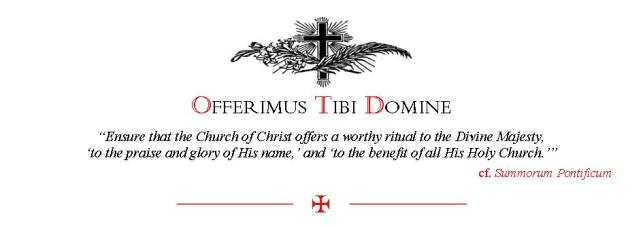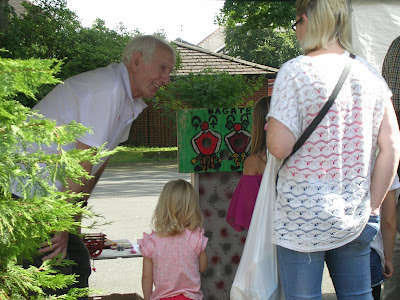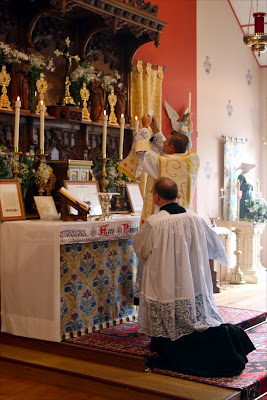Cardinal Piacenza, the Prefect of the congregation for Clergy in Rome always says things I very much like. (I have posted about him many times before here here and here, for exapmple.) Yesterday, in preparation for the Year of Faith, he gave an interview to Zenit, speaking about the Second Vatican Council. Read his words carefully and I think you can see very clearly what he is saying - and it is not the interpretation of the Council many of us hear in the local Church. I reproduce it in full ( the highlights are my own).
ZENIT: Your Eminence, ZENIT intends to inaugurate a series of
contributions for the Year of Faith, focussing attention on the Second
Vatican Council, during the 50th anniversary year. Why is there so much
debate about this ecclesiastical event?
Cardinal Piacenza: Debate is always a positive element, because it
indicates vitality and the desire for more profound understanding; the
subject of debate is not exclusively human, instead it is an Ecumenical
Council, an occurrence both human and supernatural, because the Holy
Spirit guides the Church to a progressive, full understanding of the one
revealed truth. Therefore one should not be in the least astounded that
understandings of Conciliar pronouncements should have occasioned
decades of analysis and sometimes even debates, always following along
the path of listening to that which the Holy Spirit has desired to say
to the Church during that extraordinary assembly.
ZENIT: What would you say would be the right attitude in analyzing the Council?
Cardinal Piacenza: An attitude of listening! The Second Ecumenical
Vatican Council was, in fact, the first "media" Council, whose dynamic
physiology of analysis and whose texts were immediately publicized
through modern means of communication, which did not always capture the
important actual facts and, not infrequently, orientated their
understanding in a secular way. I believe it is particularly
interesting, and perhaps even necessary, to return, or better, to
proceed toward an attentive listening to that which, really, the Holy
Spirit desired to say to the entire Church by means of the Conciliar
Fathers. [In other words, some of what we have had has not really been what the Holy Spirit was saying!] Such a dynamic of seeking a profound understanding, such a
"right attitude" is realized by means of a direct reading of the texts,
by which one may evince an authentic spirit of the Council, and their
exact place within the entirety of Church history and editorial
revision.
ZENIT: At times some choices, even by the Magisterium, appear to go "against" the Council. Is this possible?
Cardinal Piacenza: To respond that this has never happened, it is
sufficient to examine the post Conciliar pronouncements of the Authentic
Magisterium at the universal level. How much better it is to foster a
proper reception of Conciliar decisions, clarify the importance of
determined statements, sometimes duly correcting unilateral
interpretations, or even mistaken, artificially induced ones. These
interpret Spirit filled ecclesiastical events through a lens which is
exclusively human or historic. The ecclesial service of the Magisterium
is rooted in explicit Divine Will. It prepares Ecumenical Councils, acts
through them in its fullest expression and, through successive actions,
obeys them and fosters their proper reception.
ZENIT: What truly is the "hermeneutic of continuity" spoken of so often by the Holy Father?
Cardinal Piacenza: It is, according to what has been explicitly
indicated by the same Pontiff, the only correct way to read and
interpret each Ecumenical Council and, therefore, the Second Vatican
Council. The continuity of the one Body of the Church, prior to being a
hermeneutic criterion, that is a manner by which to interpret texts, is a
theological reality, which is deeply rooted in the selfsame act of
faith which prompts us to profess "I believe in One Church." For such a
reason, some sort of dichotomy between pre and post Vatican II is
unthinkable, and certainly one must refute both the positions of those
who see in the Second Vatican Ecumenical Council a "new beginning" of
the Church as well as those who discern the "true Church" only prior to
this historical Council. No one can arbitrarily decide whether and when
the "true Church" started. Sprung forth from the side of Christ, and
fortified by the effusion of the Spirit at Pentecost, the Church is One
and Only, until the consummation of history, and within the communion by
means of which will come to be actualized in eternity.
Some people sustain that the hermeneutic of reform within that of
continuity is only one of the possible hermeneutics, along with those of
discontinuity and rupture. The Holy Father has recently defined as
"unacceptable" the hermeneutic of discontinuity [There cannot be two differnt types of interpretation - "my view" and "your view" is not an option.] (Audience with the
General Assembly of the Italian Conference of Bishops, May 24, 2012).
This is obviously true: otherwise it would not be Catholic, and the germ
of infection and of progressive decomposition would be injected into
the Church; [This seems to be a very strong statement condemning the interpretation of the Council through the lens of disruption and some sort of new beginning that we have so often heard - and still do from many quarters.] also causing great damage to ecumenism.
ZENIT: Is it possible that it could be that complex to understand this reality?
Cardinal Piacenza: You know better than I do that understanding, even
of self evident realities, can be conditioned, not infrequently, by
emotional, biographical, cultural and even ideological aspects. It is
humanly understandable that someone who has lived the years of his youth
during the time of legitimate enthusiasm for the Conciliar Assembly,
understanding the desire of clearing away of some of the
"encrustations," which were necessarily and urgently removed from the
countenance of the Church, might interpret as dangerous the "betrayal"
of the Council which he sees in every manifestation which his own
"emotional state" does not share. All must necessarily take a drastic
quantum leap in approaching the Conciliar texts in order to understand,
half a century after this extraordinary event, what the Spirit proposed
to the Church, and what He proposes. To crystallize the Council within
its necessary, but not sufficient, "enthusiastic dimension" is
equivalent to not serving the reception of the Council well, as then it
remains paralyzed, since, with time, an analysis and shared evaluation
must take place of the objective texts, not certainly blemished by
emotional approaches and historical enthusiasm. [Those who were carried away with enthusiasm for what the Council might produce and who now find it hard to change their understanding of it, even in the light of the obvious decline of the Church in many countries and the failure of some of those enthusiasms.]
ZENIT: It is known that you have always spoken with great enthusiasm of Vatican II. What does the Council represent for you?
Cardinal Piacenza: How could one not be enthusiastic for such an
extraordinary event as an Ecumenical Council! In these the Church shines
forth in all her beauty. Peter and all the Bishops in communion with
him prepare themselves to hear the Holy Spirit, to that which God wishes
to say to His Spouse. They came together to articulate, according to
the predictions of Blessed John XXIII, immutable revealed truth and
reading the signs from God in the signs of the times, for the historical
present, and the signs of the times under the light of God! This same
Pontiff said in his solemn allocution at the opening of the Council, on
October 11, 1962 "To transmit doctrine purely and integrally, without
alteration or misrepresentation […] this certain and immutable doctrine
which must be faithfully respected as well as elaborated and presented
in a way which corresponds to the exigencies of our times."
During the years of the Council, I was a young student and then
seminarian, and my priestly ministry, from the first moments, was
carried out entirely in light of the Council and her reforms. In fact, I
was ordained a priest in 1969. I cannot do otherwise but call myself,
then, a son of the Council. I am grateful also to my own teachers,
because I have understood, from the start, Conciliar teachings according
to the natural hermeneutic of unity and continuity. This reform within
continuity I have always personally felt, lived, and also as a
professor, taught.
ZENIT: As Prefect of the Congregation for Clergy, do you think that priests have accepted the Council well?
Cardinal Piacenza: Certainly, insofar as an elect portion of the
People of God, priests are those who, within the Church, know better and
have developed a more profound understanding of Conciliar teaching. It
seems to me that, as of now, the same problems which we have referred to
before are not absent among priests. Whether those be with reference to
the correct hermeneutic of reform within continuity, or a necessary
approach to the Council which is not predominantly emotional. If, during
this Year of Faith, we would all have the humility and good will to
pick up the texts of the Council, discovering what they truly said, and
not that which is in the "common" understanding, which had its own
freelance proponents, [So the common understanding has not always been the correct one.] we will discover how the Second Vatican Council
was truly prophetic and how many of the matters it highlighted still
remain before us, as a horizon toward which we look, and as a goal to
reach, with the help of grace. Certainly, to accomplish this, a great
dose of humility is necessary, along with a certain capacity to suspend
pre-established judgements, to be able to reacquire the truth which,
perhaps, for too much time, has appeared to be different. [Wow! This is strong stuff.]
ZENIT: Upon which points must the reception of Conciliar documents be focused?
Cardinal Piacenza: I must refer to a matter of particular tension,
which is represented by the liturgical reform, also because this
constitutes the element which is most highly visible in the Church
herself. Again and again the Servant of God Paul VI, Blessed John Paul
II and the Holy Father, His Holiness Pope Benedict XVI have emphasized
the importance of the Liturgy, as the place in which the selfsame being
of the Church is fully realized. It does, unfortunately, catch
everyone’s attention, as, in not a few cases in its regard, we are still
far from a shared balanced understanding. Certainly a desacralized
liturgy, or that reduced to a "human representation," in which the
Christological and theological dimensions vanish until they are
displaced, is not what the letter and spirit of Sacrosanctum Concilium
intended. This does not justify, nonetheless, the position of those who
in their own turn have also wed themselves to the hermeneutic of
discontinuity, denying Conciliar reform, considering them as betrayals
of a longed for "true Church." [By this judgement. many of the liturgies we have experienced and still do, are not what Sacrosanctum Concilium intended - but nor can we turn the clock back - the "True Church" is always united with the Holy Father.]
ZENIT: Are there some innovations which are more important than liturgical ones?
Cardinal Piacenza: Given the centrality of the liturgy, "source and
summit" of the Church’s life itself (cf. SC,10) I would not speak of
"greater" importance. Certainly the Council desired to emphasize some
evangelical truths, which today represent the shared patrimony of all of
Catholicism. We might only think of the felicitous emphasis of the
universal call of all the baptized to holiness. This has fostered the
birth and development of so many new experiences. One might make
reference also to openness toward Christians belonging to other
confessions, which has caused the preciousness of unity to re-emerge, in
all its beauty, as a necessary attribute of the Church, and as a gift,
freely offered by Christ, of being ever welcoming, by means of a
continuous purification of those who belong to Him. Of equal importance
is the importance of Episcopal collegiality, which is among the most
effective expressions of Ecclesial Communion and demonstrates to the
world that the Church is necessarily a unified body. The same organic
comprehension of Ordained Ministry, in service of the baptismal
priesthood, and ultimately, which sees priests and deacons closely
united to their own Bishop, as an expression of sacramental communion in
service of the Church and of humanity, has embodied a felicitous
development of the understanding of the countenance of the Church, as
Our Lord desired to define it.
ZENIT: Your Eminence, in this moment the Church prepares to begin the
Synod for the New Evangelization and the Year of Faith. If you could
say a concise word to priests, what would you say?
Cardinal Piacenza: Under the light of faith: Priest, become every day that which you are!












































.jpg)




